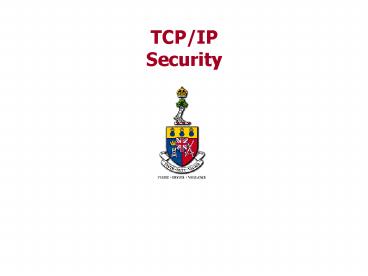TCPIP Security PowerPoint PPT Presentation
1 / 22
Title: TCPIP Security
1
TCP/IPSecurity
2
TEACHING POINTS
- TCP/IP vulnerabilities
- Mitnick attack
- firewalls
- IDS
- IPSEC, SSL, VPN
3
TCP/IP Vulnerabilities
- The TCP/IP protocol stack was developed in a
trusting environment - Passwords for telnet, ftp, mail, etc. are sent
over the network in the clear or with a known
encoding - Many of the communications protocols rely on the
participants being well behaved and truthful
4
Internetworking
Host A
Host B
Router K
Internet
Network Access
Network 2
Physical
Network 1
5
Protocol Data Units
USER DATA
TCP Header
IP Header
Net Header
6
IP Specifics
- Responsible for moving data across Internet
- Send and forget
- Does not guarantee
- Delivery
- Packets delivered in order sent
- Packets delivered undamaged
- Employed on various networking technologies
7
IP Header
0 16 31
Version
Total Length
IHL
Type of Service
Identification
Fragment Offset
Flags
Header Checksum
Time to Live
Protocol
Source Address
Destination Address
Options and Padding
8
TCP Specifics
- Provides reliable data transfer between apps
running on different hosts - Divides data into TCP segments and transmits them
using IP - Protects against data loss, corruption, packet
reordering and data duplication - Adding checksums (tx)
- Sequence Numbers (tx and rx)
- Acknowledgement packets (rx)
9
TCP Header
Source Port
Destination Port
Sequence Number
Acknowledgement Number
Data Offset
Window
Flags
Reserved
Urgent Pointer
Checksum
Options and Padding
10
TCP Header
U R G
AC K
P S H
R S T
S Y N
F I N
FLAGS
11
Three Way Handshake
A
B
SYN SN X
SYN SN Y AN X 1
AN Y 1
12
IP Spoofing
- The receiving host relies on the sending host to
tell the truth about its IP address, port
numbers, etc. - Why would you want to do it?
- Obtain root access
- Take over an open terminal and login
- Exploit applications that use authentication
based on IP addresses - How do you do it?
- Create packets with spoofed IP address
13
IP Spoofing attack - Coles Notes
- Select target host
- Discover a pattern of trust and a trusted host
- Disable trusted host
- Sample targets TCP sequence numbers
- Impersonate trusted host
- Guess sequence numbers
- Connection attempt made to a service that
requires address based authentication - If successful, attack executes simplified command
for back door
14
IP Spoofing - Considerations
- Key to the attack identify a trusted host
- Disrupt the real trusted host
- e.g. TCP SYN flooding (Denial of Service)
- Attacker sends forged packets
- Attacking host never receives ACKs
- Sent to real trusted host by routers
- Attacker must predict responses
- specifically sequence numbers need to be predicted
15
Famous Attack
- Kevin Mitnick on Tsutomu Shimomuras system in
1994 - Used SYN flooding and TCP Hijacking (spoofing)
16
Mitnick Attack
Target
Trusted Host
Attacker
17
What Did He Get?
- Caught in 1995
- 25-count federal indictment for allegedly copying
proprietary software from the computers of
cellular telephone manufacturers (Computer fraud) - 46 months and three years probation
- Released 21 Jan 2000
- Cannot have anything to do with a PC until 20 Jan
2003
18
How to Tighten-up
- Firewalls
- monitor network traffic at the point of
connection to external networks - allow or refuse traffic based on a set of rules
- restricts the set of services that are allowed to
cross the firewall (in either direction) - IDS
- intrusion detection systems
- monitor network traffic at the point of
connection to external networks and/or within
local networks - monitor the traffic flows looking for malicious
use of the network services - raises alarms on the detection of misuse
19
How to Tighten-up
- There are newer more secure protocols to use at
many layers of the protocol stack - SSH
- secure shell - replaces telnet, ftp and provides
encrypted password exchange and session
communications - IPSec
- secure IP headers and payload provide integrity
and confidentiality services between hosts - SSL
- secure socket layer - pki based authentication
and key management services to secure a
host-to-host connection - VPN
- virtual private networks - secure gateways
provide integrity and confidentiality services
between networks
20
Firewall
- Refuse
- malformed packets
- services considered unsafe
- services which should notbe available
- packets that do not belong to alegitimate
connection - Add
- extra authentication services andrules to
existing protocols
Attacker
21
Intrusion Detection System - IDS
IDS
Firewall
IDS
internet
- Monitor
- traffic that looks likescanning attempts
- traffic that should not legitimatelybe carried
on the internal network - signatures of well known attacks
- changes in patterns of user activity
Attacker
22
TEACHING POINTS
- Trojans
- TCP/IP vulnerabilities
- Mitnick attack
- firewalls
- IDS
- IPSEC, SSL, VPN

